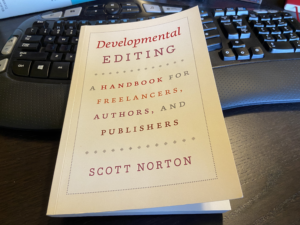If you’ve interacted with the book publishing process at all, you probably know there is not just one type of editing. There is line editing, which focuses on the use of language and how it flows within a manuscript, line by eponymous line. There is copyediting, which focuses on grammar and diction. However, in the process of turning a manuscript into a book, developmental editing comes both of them. This form of editing is all about structuring or restructuring the actual content of the book.
Ghostwriting nonfiction, at least in the way that I do it, has many intersections with developmental editing. Reading specifically about developmental editing is useful when I take the content of my interviews with authors and put them into a written format. While my goal is to write in a “clean” manner without riddling my work with grammatical errors, my primary concern is content. Editing based on grammar and flow is self-evidently technical, but developmental editing is technical in its own way—focused on organizing, amplifying, and selecting the right narratives in the work of creating each book.
You’ll find similarities in the nonfiction elements discussed below and those mentioned in my post about manuscript evaluation. Developmental editing, in some ways, is just an unabridged version of that. It doesn’t just point out problems with a text; it’s a process where the DE rolls up their sleeves to solve them.
Note: both developmental editing and the developmental editor are often referred to as DE.
Weaving a Narrative Web
When I consider developing a nonfiction book, whether that be fully writing it or winnowing existing content, I find frameworks that involve layering and weaving to be useful. Nonfiction often is not tied to a temporal narrative (except in the case of some memoir and historical accounts). Instead, it’s often about developing theses and arguments, then deciding how to structure and present them in a way that keeps readers engaged. The writing process itself is also rarely linear, as new considerations that appear in one chapter can deeply impact another.
Through a series of assertions and explorations, the author doesn’t reach the end of a road; they reach the center of a web, a series of circles that reaches a core understanding of whatever topic the text addresses. The author sits in the center of this web, a home base that is now solid, balanced, and designed specifically to lure readers to it.
Viewing Expertise as an Outsider
A person who specializes in developing manuscripts often works side-by-side with an author who is a subject matter expert. This puts them in a position to objectively observe how content is presented and evaluate whether it is coherent and authoritative. Authors can be so embedded in their subjects that they have a hard time judging what type of base knowledge their readers need to understand their points. A DE can point out what framing still needs to take place for the book to make sense. They can also identify what is relevant to the book’s thesis and make calls on whether some topics can be left out because it is either unnecessary, unrelated, derivative, or outside the scope of the author’s knowledge.
Organizing and Balancing Content
If there is one thing that makes a book inaccessible, it’s a meandering narrative that buries its points in long walls of texts. Managing 60k+ words of content can feel like trying to direct a boulder as it rolls down a hill if you don’t have a track in place to keep it on course.
One thing that I have found helpful to keep books on track both during writing and revisions is having a running record of theses, arguments, anecdotes, and illustrations as I write. It’s a shortcut to seeing whether each chapter introduces ideas so that one builds on the next, and it prevents the same stories being told over and over throughout the book. It’s also valuable to create a reference for titles, subtitles, and headers to ensure tonal consistency and avoid repeating oneself (starting with a table of contents is great for this). Without these references, writing new sections can inspire deja vu, where the only way to determine whether you’ve already covered something is to comb back through pages and pages of text.
Maintaining and Amplifying Voice
Believe it or not, editing for voice isn’t just about vibes (although I would say some consideration of vibes does come into play)! There are rules about levels of criticism, sarcasm, and condescension; there are ways to track overly enthusiastic tones, or ones that seem insincere. Maintaining consistency in these rhetorical areas can help a DE make sure the author is cast in the most authentic light possible. A friendly voice that is respectful of the book’s subject and its audience makes for a much more pleasant reading experience.
A Useful Resource for Developmental Editors and Nonfiction Writers
Developmental Editing by Scott Norton demonstrates how this process, which many people might think of as more intuitive, can be largely systematized. The techniques and systems he suggests for evaluating and improving a manuscript is much like deconstructing a faulty machine, then putting it back together (often with old parts exchanged for new) so it runs much better than it did.
I enjoyed how each chapter explored a different aspect of a DE’s job, using different imaginary books, authors, and publishing companies to illustrate the process. The examples did double duty; they didn’t only act as technical manuals, but they also provided context for working with different types of publishing houses and different temperaments of authors. One warning I’ll give is that, in the process of discussing how to prevent authors from stepping in it by producing offensive material, there was some problematic language used in reference to transgender people.
Many of his points resonated with my experience developing manuscripts and gave me some useful ideas and frameworks to improve my own work. I’m sure I will continue to refer to it as I work on future projects.




